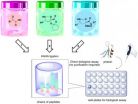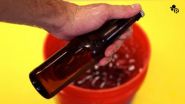(Press-News.org) PITTSBURGH, Sept. 8 – An unusual kind of immune cell in the tongue appears to play a pivotal role in the prevention of thrush, according to the researchers at the University of Pittsburgh School of Medicine who discovered them. The findings, published online today in the Journal of Experimental Medicine, might shed light on why people infected with HIV or who have other immune system impairments are more susceptible to the oral yeast infection.
Oral thrush is caused by an overgrowth of a normally present fungus called Candida albicans, which leads to painful white lesions in the mouth, said senior investigator Sarah L. Gaffen, Ph.D., professor, Division of Rheumatology and Clinical Immunology, Pitt School of Medicine. The infection is treatable, but is a common complication for people with HIV, transplant recipients who take drugs to suppress the immune system, chemotherapy patients and babies with immature immune systems.
"In previous work, we found the cytokine interleukin-17 (IL-17), a protein involved in immune regulation, must be present to prevent the development of thrush," Dr. Gaffen said. "But until now, we didn't know where the IL-17 was coming from."
Typically, IL-17 is produced by immune T-cells that learn to recognize and remove a foreign organism after an initial exposure, known as adaptive immunity. But unlike humans, mice do not normally acquire Candida during birth and are considered immunologically naïve to it. When the researchers exposed the lab animals to Candida, their IL-17 levels rose within 24 hours despite the lack of a T-cell response. This suggested the immune activity was innate, rather than acquired.
To find the cell responsible for IL-17 secretion, lead investigator Heather R. Conti, Ph.D., devised a way of applying a scientific technique called flow cytometry to sort for the first time cells gathered from the oral tissues. In the tongue, she identified unusual ones known as natural TH17 cells that looked very much like T-cells but didn't behave like them. Subsequent tests showed that the novel cells did, indeed, make IL-17 when exposed to Candida.
"These cells are part of a natural host defense system that is present at birth and does not require a first exposure to be activated," Dr. Gaffen explained. "This study demonstrates for the first time that natural TH17 cells protect against infection."
The researchers speculate that the similarities natural TH17 cells share with T-cells make them vulnerable to HIV, chemotherapy and other agents as well, which could explain why certain people are more susceptible to oral thrush. Also, new drugs that block IL-17 soon will be on the market for treatment of rheumatologic conditions, so it's possible that thrush could be a side effect.
The team plans to examine the factors that influence thrush development within the high-risk groups.
INFORMATION:
Co-authors of the paper include other researchers from the University of Pittsburgh School of Medicine, Children's Hospital of Pittsburgh of UPMC, the University of Pennsylvania, Genentech Inc., and the National Institute of Allergy and Infectious Diseases (NIAID), part of the National Institutes of Health (NIH).
The project was funded by NIH grants DE022550, AI107825, DE023815, AI095466, AI097333, AI106697, AI1110822, DE023293, AI098243 and T32-DK063922; Children's Hospital of Pittsburgh of UPMC; the Pediatric Infectious Disease Society; the Edmond J. Safra Foundation/Cancer Research Institute; and the NIAID.
About the University of Pittsburgh School of Medicine
As one of the nation's leading academic centers for biomedical research, the University of Pittsburgh School of Medicine integrates advanced technology with basic science across a broad range of disciplines in a continuous quest to harness the power of new knowledge and improve the human condition. Driven mainly by the School of Medicine and its affiliates, Pitt has ranked among the top 10 recipients of funding from the National Institutes of Health since 1998. In rankings recently released by the National Science Foundation, Pitt ranked fifth among all American universities in total federal science and engineering research and development support.
Likewise, the School of Medicine is equally committed to advancing the quality and strength of its medical and graduate education programs, for which it is recognized as an innovative leader, and to training highly skilled, compassionate clinicians and creative scientists well-equipped to engage in world-class research. The School of Medicine is the academic partner of UPMC, which has collaborated with the University to raise the standard of medical excellence in Pittsburgh and to position health care as a driving force behind the region's economy. For more information about the School of Medicine, see http://www.medschool.pitt.edu.
Unusual immune cell needed to prevent oral thrush, Pitt researchers find
2014-09-08
ELSE PRESS RELEASES FROM THIS DATE:
'Pick 'n' Mix' chemistry to grow cultures of bioactive molecules
2014-09-08
Chemists at ETH-Zürich and ITbM, Nagoya University have developed a new method to build large libraries of bioactive molecules – which can be used directly for biological assays – by simply mixing a small number of building blocks in water.
Zürich, Switzerland and Nagoya, Japan – Professor Jeffrey Bode of ETH-Zürich and the Institute of Transformative Bio-Molecules (ITbM) of Nagoya University, and his co-worker have established a new strategy called "synthetic fermentation" to rapidly synthesize a large number of bioactive molecules, which can be directly screened in ...
Trial shows improved overall survival for patients with liver cancer not amenable to surgery
2014-09-08
Singapore, 04 September 2014 – The mature results from a trial conducted by the Asia-Pacific Hepatocellular Carcinoma Trials Group led by the National Cancer Centre Singapore (NCCS) and Singapore General Hospital (SGH) have shown that patients who suffer from inoperable advanced hepatocellular carcinoma (HCC) may have a chance to live significantly longer by using a combined therapy.
The multi-centre phase II clinical trial was conducted at four Asia Pacific tertiary medical centres to evaluate the efficacy of combining two existing treatment modalities, Sorafenib and ...
New knowledge of cannabis paves the way for drug development
2014-09-08
Revolutionary nanotechnology method could help improve the development of new medicine and reduce costs. Researchers from the Nano-Science Center and the Department of Chemistry at the University of Copenhagen have developed a new screening method that makes it possible to study cell membrane proteins that bind drugs, such as cannabis and adrenaline, while reducing the consumption of precious samples by a billion times.
About 40% of all medicines used today work through the so-called "G protein-coupled receptors". These receptors react to changes in the cell environment, ...
Study examines discrimination among homeless adults in Toronto with mental illness
2014-09-08
TORONTO, Sept. 8, 2014—Vulnerable populations in ethnically diverse Toronto reported more discrimination by health care workers based on their housing status, mental health or substance abuse issues than race, a new study has found.
Forty-two per cent of people surveyed reported at least one form of perceived discrimination by health care workers, lead author Dr. Vicky Stergiopoulos wrote in a paper published today in the journal BMC Health Services Research.
The most prevalent form of perceived discrimination was due to mental illness or substance abuse (33 per cent) ...
Poor recording of physical health and medication could be causing dementia trials to fail
2014-09-08
Dementia trials could be failing because they all-too-often overlook the physical health of patients – according to new research from the University of East Anglia and Aston University.
More than 60 per cent of people with dementia are estimated to have three or more other conditions (co-morbidities).
The research shows how the combined effects of co-morbidities including diabetes, lung disease, arthritis and chronic heart failure are not being adequately described in dementia trials.
It investigates the extent of co-morbidities in people with dementia and the recording ...
Food craving is stronger, but controllable, for kids
2014-09-08
Children show stronger food craving than adolescents and adults, but they are also able to use a cognitive strategy that reduces craving, according to new research published in Psychological Science, a journal of the Association for Psychological Science.
"These findings are important because they suggest that we may have another tool in our toolbox to combat childhood obesity," says psychological scientist and lead researcher Jennifer A. Silvers, a post-doctoral fellow at Columbia University in the laboratory of Professor Kevin Ochsner.
Most interventions aimed at ...
Quick-cooled beers, perfect burgers and more: Chemistry Life Hacks, Vol. 3 (video)
2014-09-08
WASHINGTON, September 8, 2014 — It's the series that's one-part MacGyver, one-part Mendeleev. "Chemistry Life Hacks" is back with new tips that can change your life, or at least the temperature of your beer. Learn how to cool your brews quickly before the big game starts, get fruit flies out of your kitchen for good, and how to cook the perfect patty on the grill. Check out these tips and more at: http://youtu.be/QUE2O1276P8.
Subscribe to the series at Reactions YouTube, and follow us on Twitter @ACSreactions to be the first to see our latest videos.
INFORMATION:
The ...
Layered graphene sandwich for next generation electronics
2014-09-08
Writing in Nature Nanotechnology, the researchers have demonstrated how combining the two-dimensional materials in a stack could create perfect crystals capable of being used in next generation transistors.
Hexagonal boron nitride (hBN), otherwise known as white graphene, is one of a family of two-dimension materials discovered in the wake of the isolation of graphene at the University in 2004. Manchester researchers have previously demonstrated how combining 2D materials, in stacks called heterostructures, could lead to materials capable of being designed to meet industrial ...
Light detector to revolutionize night vision technology
2014-09-08
Researchers have developed a light detector that could revolutionise chemical sensing and night vision technology.
In the latest issue of Nature Nanotechnology, the team of researchers at Monash University, the University of Maryland in the US, and the US Naval Research Laboratory, have created the light detector based on graphene – a single sheet of interconnected carbon atoms.
The detector is capable of detecting light over an unusually broad range of wavelengths, included in this are terahertz waves – between infrared and microwave radiation, where sensitive light ...
Doped graphene nanoribbons with potential
2014-09-08
Graphene is a semiconductor when prepared as an ultra-narrow ribbon – although the material is actually a conductive material. Researchers from Empa and the Max Planck Institute for Polymer Research have now developed a new method to selectively dope graphene molecules with nitrogen atoms. By seamlessly stringing together doped and undoped graphene pieces, they were able to form "heterojunctions" in the nanoribbons, thereby fulfilling a basic requirement for electronic current to flow in only one direction when voltage is applied – the first step towards a graphene transistor. ...




